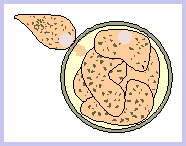 |
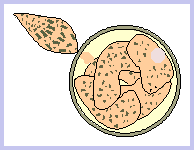 |
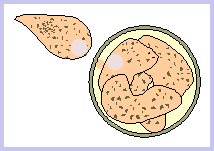 |
| Usually, when we witness special natural phenomena,
our childlike sense of wonder predominates, and only later do we recognize
nature's indifference to the life forms that enact what we think of as
almost miraculous. Having read Eric Gravé on en- and excystment
in his Using the Microscope, I was somewhat prepared for what I
saw the other evening. For one (happy) thing, I recognized what I was seeing
and knew enough to wait and watch the process complete itself. For another
(less happy), I remembered what Gravé had written about ciliate
reproduction, that daughter cells, attached by no bonds of familial empathy,
are literally struggling against each other for their lives. I remembered
also that Helena Curtis in The Marvelous Animals points out that
encystment evolved to protect the live material inside and that how to
get outside seems a problem for the young organisms to solve by trial and
error. Or, more accurately, the interior cyst "walls" may have developed
a means of egress, but many species' second, outer "walls"—developed for
security, not accessibility—make leaving a resting cyst an extremely arduous
act.
Think of what follows as a serious comic strip. It's
the record of my having seen several Colpoda excyst. I've added
colors to make the parts of the images easier to recognize. The white background
is factual bright-field, and the cyst wall is close to the color I actually
saw. In fact, as you probably know already, the organisms and the
inside of their cyst were various shades of transparent. I've given one
of the encysted critters a vacuole it did not develop until the second
or third panel, the better for you to know which one is the main or title
"character."
Only one day after I made an infusion from old, sun-baked cattle manure, I noticed that Colpoda had appeared and were an average of 40 microns in length. When the infusion was about 48 hours old, Colpoda were still the only protists active; some were 60 microns long (yesterday's critters now well fed?) but most were the smaller size. I noticed some round objects, 40 microns in diameter, apparently organic with a thick outer membrane or wall and indeterminate contents. Then I saw one that was different: there was a moving triangle attached to it, there were whirls in the water and bacteria outside of it, and some things inside it were tumbling and rotating not quite fast enough to be a blur. I began to pay close attention. |
 |
 |
 |
| At 600X the "triangle" becomes a small Colpoda. It's attached to the round thing, which—with what appear to be other Colpoda inside—seems to be a resting cyst. From the bit of matter at the Colpoda's posterior end, it looks like the organism is still partly inside the cyst. The contents of the cyst tumble and move about in concert and also individually. | The Colpoda is pulling the cyst around. I can see whirls on either side of the critter, where bacteria and debris are being disturbed by its efforts. I can also see the Colpoda lengthen as it pulls, and longitudinal lines—they must be its myonemes—appear on the critter's "back." The Colpoda seems to be getting larger. I measure it—25 microns long, 5 longer than it was at first. | The organism continues to pull, and what's inside the cyst continues to revolve and tumble. I'm almost sure now that the interior is filled with small, active Colpoda-to-be; one even has a vacuole. Then, suddenly, the Colpoda is free-swimming, showing no more or less effort than it had when it was still attached. It seems to have left a little bit of itself inside, but it looks and acts whole and healthy. It swims out of view. |
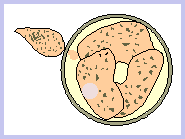 |
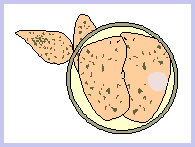 |
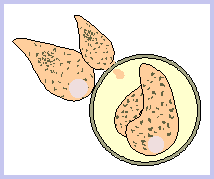 |
| A second Colpoda begins to emerge from the cyst almost immediately, and its posterior end is almost touching that bit of cytoplasm that the first critter left inside. I conclude that it's likely that this species of Colpoda has resting cysts with discrete exit locations (contrasted to cysts that fall apart as a new organism emerges). According to Rainis' Guide to Microlife, Colpoda cysts are remarkably durable; maybe new Colpoda need a ready-made hole in a cyst wall so strong that it has remained intact, possibly, for years. | The second Colpoda grows a little, but it's nowhere near the size of its predecessor when a third critter pushes itself through what has to be the exiting place. Both Colpoda are attached to the cyst and apparently attached in a way that keeps them in the same location. More of the third critter appears. It begins to pull against the cyst. I see that the interior of the cyst is less crowded. I was right several minutes earlier, when I counted three organisms inside after the second Colpoda came out. Now, with the third one outside also, it's clear that there are only two remaining within. | The two Colpoda pull, making nearby bacteria and detritus swirl around the cyst. They each pull independently, in the same direction. I think of Gravé: if they pulled in opposite directions, their work would be more productive. But they just pull. Within the cyst, the critter with the vacuole looks bigger than the other one. It's swimming and tumbling very strongly. I'm amazed that these organisms can grow and expend such energy without eating (or, in the case of those outside, not eating much while working very hard). The one with the vacuole is now actually as large as the larger of the two Colpoda outside. |
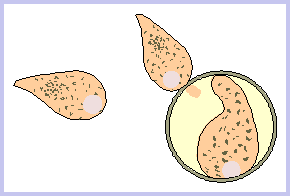 |
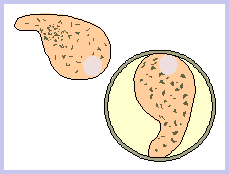 |
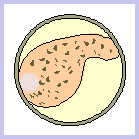 |
| Then the second Colpoda to leave the cyst swims free. The third remains attached, still growing and pulling. Looking at the interior of the cyst again, I do a double-take: there's only one organism! I watch through several revolutions of it inside the cyst: nothing but the organism with the vacuole. I think it crushed the other one. | In a minute or two, the third Colpoda is free-swimming and gone. The one inside seems huge, or did the cyst itself shrink? I measure; the cyst is still 40 microns, but the last Colpoda must be nearly that, longer than the others when they swam away. Is this critter too big for the hole? | The remaining Colpoda continues to swim and tumble. I wonder: even if it's larger than the others when they emerged, it's probably stronger, too. It should be able to push through. It's ready. |
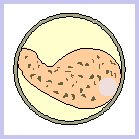 |
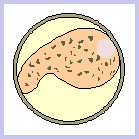 |
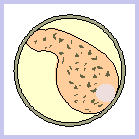 |
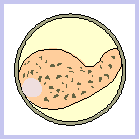 |
| It's at the exit, and it seems to be pushing at it. It doesn't leave the cyst, though. | It resumes swimming and revolving, continuing to move energetically. | It's found the exit place again, pushes again, but it doesn't get through. | After 45 minutes, it's still inside. It's going slower. I think it's trapped. |
|
This incident, from the first cartoon panel to the last, took about two hours. The biggest, strongest young Colpoda never got out of the resting cyst. The process and its results raise some questions. Since I came upon the cyst with one Colpoda outside already, I don't know if any had emerged earlier. According to Gravé, Colpoda resting cysts usually contain one individual, but his micrographs are of Colpoda aspera, whereas the critters I saw look most like the Jahns' drawing of Colpoda cucullus in How to Know the Protozoa; the organisms I watched excyst are pretty surely some Colpoda species. In the same infusion, later, I found (on five slides) twenty-five more cysts with multiple occupants, and no cysts with just one. So I'd say it's normal for this species of Colpoda to multiply after encysting. For four reasons—the sturdiness of the outer cyst covering, the lack of external cilia on the cyst, the difficulty experienced by the young in getting out, and the range-dried state of the infusion material—I'm sure the cysts I saw were resting cysts, not reproductive ones. (Gravé says that Colpoda form cysts to reproduce: one organism encysts, division takes place, and four or sometimes eight new individuals emerge; but they emerge from a ciliated reproductive cyst simultaneously with the cyst's breaking apart into four or eight pieces.) Okay. But what about the last two critters in the cyst I watched? If the main character had eaten its cyst-mate, I would have noticed a food vacuole and its contents. But what I saw was that there were two Colpoda in the cyst and then there was one; the simplest explanation is that, moving about, the larger organism (and probably the others, earlier) battered the smaller one until it decompressed— until its outer membrane weakened, and burst, and let its cytoplasm escape into the medium inside the cyst. Since the left-over pieces of the earlier-emerging Colpoda had apparently dissolved, the even littler pieces of the fifth Colpoda should have dissolved, too. By the end, there was nothing in the cyst but the fourth, large Colpoda. Now, here is where the main character becomes a hero, much more than the Hemingway character that my title alludes to.* Altruism. It's a word that occurs in glossaries of biological terms. In this case, as in most cases of biological altruism, the self-sacrifice isn't intentional or conscious; it just happens, and if it works when it happens, we call it an instance of natural selection. Looking at those little Colpoda squeezing through the exit, I wondered how they did it. The hole may have gotten larger with use, but none of the emergent organisms simply swam out; they went in the exit, they came partly out of the exit on its other side, they came virtually all the way out of the exit, and then they swam away when their attachment broke. Question: what did they
have that the last Colpoda didn't —besides the luck and/or biological
inclination to get into the exit hole sooner? Answer:
bodies inside the cyst to push against while they were squeezing through.
As more of the Colpoda emerged, one body, growing bigger by the
minute, remained. It did its job.
|
|
* "The Short, Happy Life of Francis McComber" tells how the title character, at first too scared to stand his ground in front of a charging, wounded lion, acquires courage and dies unafraid.) |
Comments to the author Rosemarie Arbur are welcomed.
Please report any Web problems or offer
general comments to the Micscape
Editor,
via the contact on current Micscape
Index.
Micscape is the on-line monthly magazine
of the Microscopy UK web
site at Microscopy-UK